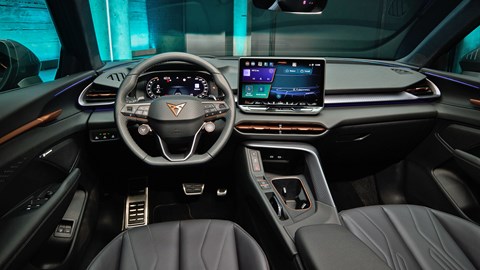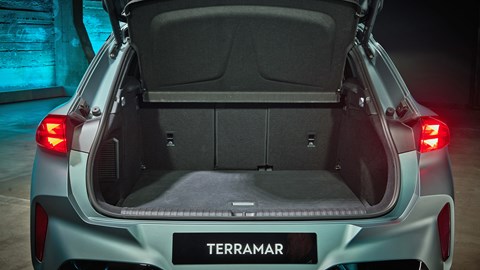► Revealed in Barcelona
► Five ICE powertrains available
► Deliveries start Q1 2025
This is your latest look at the Terramar, an all-new ICE-powered SUV from Cupra. Based on the VW Group’s MQB Evo platform, an early example was shown around two years ago at the brand’s Impulse event – but now it’s ready for production.
The Cupra Terramar represents the next stage in our growth journey,’ said Wayne Griffiths at the car’s launch in Barcelona. ‘A sporty SUV that will bring the young and challenger mindset of Cupra to a broader audience, expanding the brand and appealing to new customers who are looking for more emotion and performance.’
The Terramar will also benefit from Cupra’s new strategic alliance with the America’s Cup: the car launched during the competition’s 37th edition, and Cupra will make 1337 America’s Cup Terramar models– all with special design touches inside and out.

Wait, it’s not electric?
It is not. Cupra wants to reach a larger audience with the Terramar, and that means that unlike the flagship Tavascan and Born EVs, the Terramar sticks to old-fashioned combustion. That’ll keep the price down, the range up – and in theory keep the sales up too. At least that’s what Cupra’s hoping.

There’s reason for the suits to be confident though. It’s a formula that continues to work well for Cupra even if it’s not totally in keeping with its futuristic, electric image as both the Leon and the Formentor models continue to sell well. Throw in wavering demand for EVs as well as an uncertain geopolitical climate, and Cupra’s decision to add another hybrid to the mix feels like a prescient one.
With that in mind, customers will be able to choose from five different powertrain options: there’s an entry-level 1.5-litre 48V mild hybrid with 110kW (148 bhp) and a seven-speed DSG. Next there’s a pair of petrol engines; a 2.0-litre TSI with 150kW (201 bhp) with a seven speed DSG and four-wheel drive – and another with 195kW (262 bhp) for the hotter VZ car.

There’s also a pair of eHybrids: a 150kW (201 bhp) 1.5-litre system, and 200kW (268 bhp) system with the same displacement, both of which use a 19.7kWh battery pack. The latter allows for 70 miles of EV-only charge.
What else?
The Terramar slots neatly in the mid-sized crossover arena, measuring 1584mm tall, 1863mm wide, 4519mm long – and with a wheelbase of 2681mm. And as you’d expect, every millimetre carries Cupra’s now distinctive styling.

You’ll find the same triple-triangle lights as elsewhere on the range, the same flashes of copper, and the same rear-light treatment – complete with Cupra branding too. The main difference between the most recent cars and the Terramar, though, is the addition of a gaping grille to feed the five ICE powertrains above.
I’ll run on 18-, 19- or 20-inch alloy wheels, and nine exterior colours are available including two matte options – this is Cupra after all.
What about the interior?
The Terramar isn’t as adventurous inside as its Tavascan sibling, but Cupra’s designers have done their best to keep things interesting. Front and centre is a 12.9-inch infotainment screen, and the rest of the interior is pretty similar to what you’d find in the Leon.

Still, there’s a head up display, the HMI has been improved and there’s also an illuminated touch slider – an improvement over the hard-to-see original in older VW Group cars.
Three ‘interior characters’ are available, each with varying amounts of sustainability points. Deep Ocean uses 100% upcycled Seaqual yarn, Moon Light uses 73% – and the High Canyon trim ops for leather that uses a plant-based tanning process. Slightly less sustainable, then.

Luggage load isn’t bad either, with a maximum of 602-litres.
Anything else?
Aside from the premium feel, the Terramar will need to differentiate itself from the competition with a unique driving experience. To that end, it uses front MacPherson struts and a rear multilink suspension setup which has been lowered 10mm compared to the usual MQB Evo ride height. The steering has been tinkered to improve the feel and reaction of the Terramar, and an electric brake booster aims to improve response and improve the feel of braking during regeneration.

Key to the mix, however, is the Terramar’s Dynamic Chassis Control brain and two-valve shock absorbers, which can be put in a range of modes. There’s Comfort, Performance, Individual and Off-road on all models, while the higher-end VZ models gets the hardcore Cupra mode, too. Cupra will let you turn the ESC to Sport on all powertrains, but will let you turn it off altogether on the hotter VZ versions.

What about the price?
We’re expecting the Terramar to cost around £40k. It’ll be made in Audi’s Gyor plant in Hungary and deliveries to customers will start in Q1 of 2025.